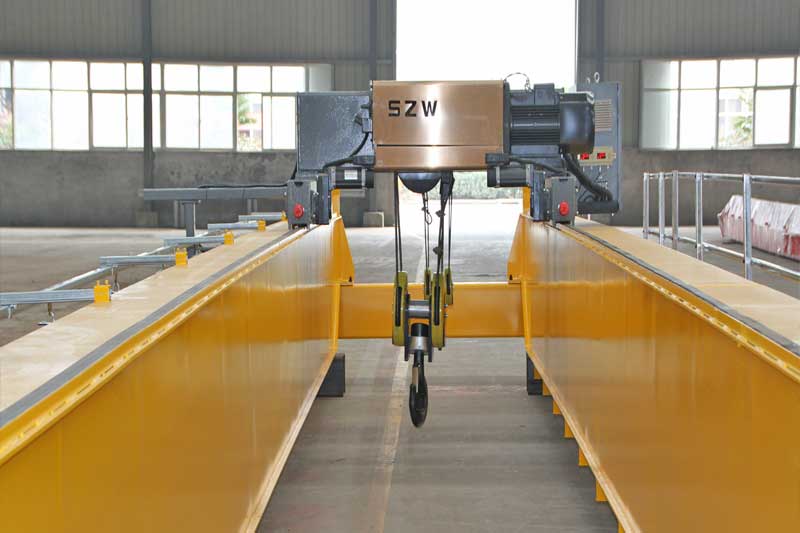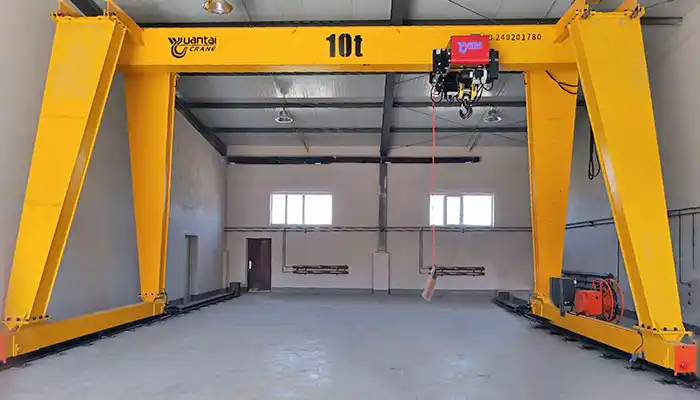Unique Safety Hazards of Overhead and Gantry Cranes
Overhead and gantry cranes play a crucial role in industries like steel production, warehousing, and construction. They handle heavy loads with precision, making operations more efficient and reducing manual labor.
However, these powerful machines come with serious risks. Working high above the ground, moving massive loads, and relying on mechanical and electrical systems all introduce potential dangers. A single failure or oversight can lead to accidents, injuries, or costly damage.
Some hazards are easy to spot, like exceeding load limits. Others, such as electrical issues or poor communication, can go unnoticed until it's too late. Understanding these unique risks is key to preventing accidents.
This guide explores common hazards of overhead and gantry cranes and offers practical safety tips. With proper knowledge and preventive measures, you can create a safer working environment and reduce risks before they turn into serious problems.
Common Safety Hazards of Overhead and Gantry Cranes
Structural and Mechanical Hazards
Overhead and gantry cranes face constant stress due to heavy lifting. Without regular maintenance, small defects can escalate into major failures that put workers and equipment at risk.
- Load-bearing failures: Over time, components like beams, hoist ropes, and trolley parts can become damaged. Cracks in beams or frayed ropes, for example, can weaken the crane. If these issues aren't addressed, a sudden failure can cause the load to drop, leading to dangerous accidents.
- Structural fatigue: Repeated lifting cycles put continuous stress on metal parts. While the crane may appear to be in good condition, internal stress can weaken materials, making them more susceptible to cracks or failure over time. This kind of damage can be hard to detect but can lead to serious breakdowns.
- Improper installation: If the crane isn’t installed or aligned correctly, it can cause misalignment during operation. Misaligned rails or faulty installation may lead to excessive wear and tear, increasing the risk of mechanical failure or instability.
Routine inspections are key to preventing these issues. Regular checks of beams, welds, hoist ropes, and other structural components help catch potential problems early. Maintaining these parts ensures the crane continues to operate safely and reliably.
Electrical Hazards
Electricity is essential for crane operation, but it also poses serious risks if not properly managed.
- Risk of electrocution – Faulty wiring, exposed cables, or improper grounding can put workers at risk of electric shock. Accidental contact with live power lines is especially dangerous.
- Crane contact with energized structures – Overhead cranes operate near metal frameworks, power lines, and other electrical sources. If a crane touches an energized structure, it can create a deadly circuit.
- Malfunctioning control systems – Electrical faults can cause unintended crane movements. Sudden stops, jerky motions, or an unresponsive control panel can lead to accidents.
Regular electrical inspections and proper grounding can help prevent these hazards. Operators should always check for exposed wires, test emergency stops, and ensure power sources are properly maintained.
Load-Related Hazards
Handling heavy loads comes with its own set of dangers. Mistakes in lifting and positioning can lead to serious accidents.
- Overloading – Exceeding the crane’s rated capacity can strain mechanical components and increase the risk of structural failure.
- Unbalanced or swinging loads – A poorly secured load can shift or swing, making it harder to control and increasing the chance of collisions. Sudden movements can also put workers in danger.
- Load drop hazards – A faulty hoist mechanism, worn-out slings, or improper rigging can cause a load to detach and fall unexpectedly.
Proper load calculations, secure rigging, and routine hoist inspections are critical for preventing these risks. Operators must always confirm load limits and follow safe lifting procedures.
Operational Hazards
Crane operation requires precision and coordination. When visibility or communication fails, accidents can happen.
- Blind spots and poor visibility – Operators often have limited sight of the load and surrounding area. Obstacles, lighting conditions, or high-stacked materials can block their view, increasing the risk of collisions.
- Miscommunication with ground workers – Cranes rely on clear signals for movement. If the operator and ground crew don’t communicate properly, it can lead to lifting errors or accidents.
- Unexpected crane movements – Improper signaling, control malfunctions, or sudden operator mistakes can cause the crane to move unpredictably, putting nearby workers at risk.
Using clear hand signals, radio communication, and proper signaling devices can help prevent these issues. Spotters or cameras can also improve visibility in difficult areas.
Environmental and Workplace Hazards
Crane performance can be affected by external conditions. Ignoring environmental factors can lead to safety risks and equipment damage.
- Extreme temperatures – Heat can cause electrical components to overheat, while cold weather can make metal brittle and reduce hydraulic efficiency.
- Corrosive or hazardous environments – Steel mills, chemical plants, and marine settings expose cranes to moisture, chemicals, and dust, which can wear down parts faster.
- Wind and weather conditions – Outdoor gantry cranes are vulnerable to strong winds, rain, and storms. Sudden gusts can swing loads or even tip over lightweight cranes.
Regular maintenance, protective coatings, and weather monitoring help keep cranes safe in challenging environments. Operators should also follow safety protocols when working in extreme conditions.
Inspection and Maintenance for Hazard Prevention
Regular inspections and maintenance keep overhead and gantry cranes safe and reliable. A small issue, if ignored, can turn into a major failure.
Importance of Regular Inspections and Pre-Operation Checks
Before using a crane, operators should always perform a pre-operation check. This helps catch potential problems early, reducing the risk of accidents. Regular inspections ensure that worn-out parts are replaced before they fail.
Key Areas to Inspect
Certain parts of a crane are more prone to wear and damage. These should always be checked:
- Hoists and cables – Look for fraying, kinks, or worn-out wire ropes. A damaged cable can snap under load.
- Brakes – Test for responsiveness. Weak brakes can cause uncontrolled load movement.
- Limit switches – Ensure they stop the crane at the correct points to prevent over-travel and collisions.
- Structural components – Check beams, joints, and fasteners for cracks or looseness.
Preventive Maintenance Best Practices
Routine maintenance keeps cranes in top condition. Follow these best practices:
- Lubricate moving parts to reduce friction and wear.
- Replace worn cables and faulty electrical components promptly.
- Keep rails and tracks clean to prevent misalignment.
- Test emergency stop systems regularly.
Compliance with Industry Standards
Crane maintenance should follow industry guidelines like OSHA, ISO, and manufacturer recommendations. These standards ensure equipment safety and legal compliance. Regular audits and certified inspections help meet these requirements.
A well-maintained crane is a safe crane. By sticking to inspections and maintenance schedules, you can prevent breakdowns and keep operations running smoothly.
Safe Operation Practices for Overhead and Gantry Cranes
Operating overhead and gantry cranes safely requires more than just knowing how to drive the machine. It’s about understanding the risks and following strict safety protocols. Let’s look at some key practices to reduce accidents and improve safety on the job.
Proper Operator Training and Certification Requirements
One of the most important safety practices is ensuring that crane operators are properly trained and certified. This is not just a requirement—it's essential for safe operation. Trained operators will:
- Understand crane controls and how to manage the load efficiently.
- Be familiar with load limits, ensuring they don’t exceed safe capacity.
- Know emergency procedures and how to respond in dangerous situations.
Certification is typically required by law (OSHA, for example), and ongoing training ensures operators are up to date with the latest safety standards.
Load Handling Techniques to Minimize Risk
Handling loads safely is critical to preventing accidents. Operators should:
- Lift loads slowly and smoothly to avoid sudden jerks or swings that could lead to a loss of control.
- Balance the load properly. Ensure it’s evenly distributed on the crane to prevent tipping or tilting.
- Use the correct lifting accessories like slings, hooks, or clamps for the specific load. The wrong gear can lead to accidents, so always match the equipment to the load type.
- Check the load before lifting. Make sure it is securely attached and won’t shift or fall during the move.
Effective Communication Methods
Clear communication is key when working with overhead and gantry cranes. It ensures that everyone on the ground and the operator are on the same page, minimizing risks. Common methods include:
- Radio signals – Radios allow crane operators and ground workers to communicate over distances or in noisy environments.
- Hand gestures – Standardized crane hand signals are used when radios are not available or when working in areas with high noise.
- Warning signals – Visual signals, like lights or alarms, warn nearby workers when a crane is in motion or about to lift a load.
Using these communication methods reduces confusion and helps everyone stay safe while the crane is in operation.
Emergency Stop Procedures and Contingency Planning
Emergencies can happen, even with the most well-maintained cranes. It’s essential that operators know how to react quickly:
- Emergency stop buttons should be easy to access and tested regularly to ensure they work when needed.
- Power shutdown procedures should be clear for operators in case of a power failure or malfunction.
- Contingency plans for various emergencies—such as a load falling or a crane malfunctioning—should be in place. This includes knowing evacuation routes and having a response team ready.
Having these procedures set up means that, if something goes wrong, everyone knows what to do, and the risk of injury or damage is minimized.
By following these safe operation practices, crane operators can minimize risks and ensure that crane operations are efficient and accident-free.
Conclusion
In conclusion, overhead and gantry cranes come with a variety of unique hazards that can pose serious risks to both operators and workers. These hazards include structural and mechanical failures, electrical issues, load-related dangers, and environmental factors. Recognizing these risks is the first step toward preventing accidents and maintaining a safe working environment.
Mitigating these hazards requires proactive efforts, such as regular inspections, proper training, and clear communication between operators and ground workers. Implementing safe operation practices, like proper load handling and emergency response procedures, ensures that cranes are used efficiently without putting anyone in harm's way.
It’s essential to prioritize safety in crane operations. A strong safety culture not only protects workers but also helps maintain the integrity of equipment and minimizes costly downtime.
To create a safe working environment:
- Ensure all crane operators are properly trained and certified.
- Conduct regular inspections and maintenance to catch problems early.
- Use clear communication and follow standard signaling practices.
- Have emergency stop procedures and contingency plans in place.
By committing to these safety practices, you can ensure that your crane operations run smoothly and safely, reducing the chance of accidents and injuries in the workplace. Safety isn’t just a set of rules—it’s a shared responsibility that benefits everyone.




